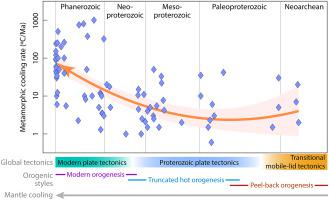Gondwana Research ( IF 6.1 ) Pub Date : 2021-02-10 , DOI: 10.1016/j.gr.2021.02.003 Priyadarshi Chowdhury , Sumit Chakraborty , Taras V. Gerya

|
The pressure-temperature-time (P-T-t) evolution of metamorphic rocks is directly related to lithosphere dynamics as different tectonic settings vary in their thermal architecture. The shapes of P-T paths and thermobaric ratios (T/P) of metamorphic rocks have been extensively used to distinguish different tectonic domains. However, the role of metamorphic timescales in constraining tectonic settings remains underutilized. This is because of the poorly understood relationship between them, and the difficulty in accurately constraining the onset and end of a particular metamorphic event. Here, we show why and how the intrinsic relationship between thermal regime, rheology and rate of motion controlled by the heat, mass and momentum conservation laws translate to differences in heating, cooling, burial, exhumation rates of metamorphic rocks and thereby, to the duration of metamorphism. We compare the P-T-t paths of the orogenic metamorphic rocks of different ages and in particular, analyse their retrograde cooling rates and durations. The results show that cooling rates of the metamorphic rocks are variable but are dominantly <50 °C/Ma during most of the Precambrian before increasing by an order of magnitude (>100 °C/Ma) during the late Neoproterozoic to Phanerozoic. To seek what controlled this secular change in metamorphic cooling rates, we use thermomechanical modelling to calculate the P-T-t paths of crustal rocks in different types of continental orogenic settings and compare them with the rock record. The modelled P-T-t paths show that lithospheric peel-back driven orogenic settings, which are postulated as an orogenic mode operating under the hotter mantle conditions of late Archean to early Proterozoic, are characterised by longer durations of metamorphism and slower cooling rates (a few 10s of °C/Ma) as compared to the modern orogenic settings (a few 100s of °C/Ma) operating under relatively colder mantle conditions. This is because peel-back orogens feature: (1) hot lithospheres with very high crustal geotherms being sustained by high mantle heat-flow and profuse magmatism, and (2) distributed deformation patterns that limit vertical extrusion (exhumation) of the metamorphic rocks along localized deformation zones and instead, trap them in the orogenic core for a long time. In contrast, modern orogens mostly involve colder lithospheres and allow rapid exhumation through localized deformation, which facilitates faster cooling of hot, exhumed metamorphic rocks in a colder ambience. Thus, we propose that the secular change in metamorphic cooling rates indicates a changing regime of orogenesis and thereby, of plate tectonics through time. Predominance of the slower metamorphic cooling rates before the Neoproterozoic indicate the occurrences of peel-back orogenesis and truncated hot (collisional) orogenesis during that time, while the appearance of faster cooling rates since the late Neoproterozoic indicates the transition to modern style of orogenesis. A transition between these orogenic styles can also account for the prolonged longevity (>100 million years) of many Precambrian orogenic belts as compared to the Phanerozoic ones. This study underscores the strength of timescales in combination with P-T paths to distinguish tectonic settings of different styles and ages.
中文翻译:

时间可以证明:变质时标的长期变化及其构造意义
变质岩的压力-温度-时间(PTt)演化与岩石圈动力学直接相关,因为不同的构造环境在其热力构造上会有所不同。PT路径的形状和热压比(T / P)变质岩已被广泛用于区分不同的构造域。但是,变质时标在限制构造环境中的作用仍未得到充分利用。这是因为它们之间的关系知之甚少,并且难以准确地限制特定变质事件的发生和结束。在这里,我们说明了为什么以及受热,质量和动量守恒定律控制的热状态,流变学和运动速率之间的内在关系以及如何将其转化为变质岩的加热,冷却,埋葬,放化率以及持续时间的差异。变质。我们比较PTt年龄的造山变质岩石的路径,特别是分析它们的逆行冷却速率和持续时间。结果表明,变质岩的冷却速率是可变的,但在前寒武纪的大部分时间内,变质岩的冷却速率主要为<50°C / Ma,而在新元古代至变生代晚期,变质岩的冷却速率却增加了一个数量级(> 100°C / Ma)。为了寻求控制变质冷却速率长期变化的因素,我们使用热力学模型来计算不同类型的大陆造山环境中地壳岩石的PTt路径,并将其与岩石记录进行比较。PTt模型路径显示,岩石圈带回驱动的造山环境被假定为造山模式,在太古宙晚期至元古代早期的较热地幔条件下运行,其特征是变质持续时间更长,冷却速度较慢(几分之十°C /相对于在较冷的地幔条件下运行的现代造山环境(几百摄氏度/马)。这是因为回剥造山带具有以下特征:(1)地热非常高的热岩石圈被高的地幔热流和大量的岩浆作用所维持,(2)分布的变形模式限制了变质岩沿垂直方向的挤压(掘出)局部变形带,而是将其长时间困在造山带中。相反,现代造山带大多涉及较冷的岩石圈,并允许通过局部变形快速发掘,这有助于在较冷的环境中更快地冷却发掘出的热变质岩石。因此,我们提出变质冷却速率的长期变化指示造山作用的变化机制,从而指示板块构造随着时间的变化。在新元古代之前变质冷却速率较慢的优势表明在此期间回削造山运动和热(碰撞)造山带被截断,而自新元古代晚期以来出现的更快的降温速率表明向造山运动的过渡。与造山带相比,这些造山方式之间的过渡也可以解释许多前寒武纪造山带的延长寿命(> 1亿年)。这项研究强调了时标与PT路径相结合的优势,以区分不同风格和年龄的构造环境。



























 京公网安备 11010802027423号
京公网安备 11010802027423号